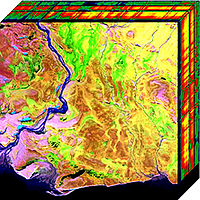
Photo from wikipedia
Significance In neurodegenerative diseases, proteins fold into amyloid structures with distinct conformations (strains). There is a need to rapidly identify these amyloid conformations in situ. Here, we use machine learning… Click to show full abstract
Significance In neurodegenerative diseases, proteins fold into amyloid structures with distinct conformations (strains). There is a need to rapidly identify these amyloid conformations in situ. Here, we use machine learning on the full information available in fluorescent excitation/emission spectra of amyloid-binding dyes to identify six distinct different conformational strains in vitro, as well as amyloid-β deposits in different transgenic mouse models. Our imaging method rapidly identifies conformational differences in Aβ and tau deposits from Down syndrome, sporadic and familial Alzheimer’s disease human brain slices. We also identified distinct conformational strains of tau inclusions in astrocytes, oligodendrocytes, and neurons from Pick’s disease. These findings will facilitate the identification of pathogenic protein aggregates to guide research and treatment of protein misfolding diseases.
Journal Title: Proceedings of the National Academy of Sciences of the United States of America
Year Published: 2023
Link to full text (if available)
Share on Social Media: Sign Up to like & get
recommendations!